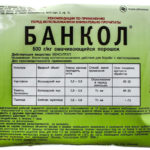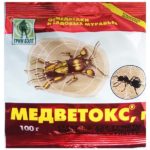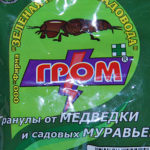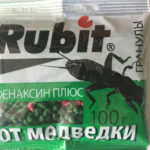Medvedka - a dangerous and insidious pest in the garden. It is dangerous because it gnaws the roots of young seedlings of many cultures planted in the spring on the beds. And insidious that it is quite difficult to get rid of it. Nevertheless, if desired and diligent, any gardener is able to fight and get rid of this insect pest forever. Next, we consider the methods of combating the parasite in the dacha.
Table of contents
Appearance of the bear in the garden and the garden
Adult insect in the greenhouse or at the cottage
Let's start with the description. Recognizing an ordinary medvedka in appearance among other insects is not difficult: The size of an adult individual is from 3 to 5-6 cm, and sometimes even reaches a length of 8 cm, depending on the conditions of its habitat and “food”. This voracious pest eats everything in its path underground - the roots of plants, the seeds of freshly sown crops, even small insects. Where is the parasite and where does it come from?It lives in well-fertilized and moist soils, i.e. a vegetable garden or a dacha, sown fertile land is an ideal place for it.
How old is living? The whole cycle of life takes about 3.5 years. Appears usually from neighbors - careless gardeners.
Medvedka looks quite remarkable and intimidating:
- head and chest covered with dark brown common armor;
- on the head there are long whiskers, short tentacles and eyes;
- the abdomen is soft, not protected by armor, three times longer than the cephalothorax;
- at the end of the abdomen there are processes resembling a mustache;
- wings long, thin, with scales;
- There are 3 pairs of limbs: the front are short, thickened, covered with armor, resemble the claws of a crab, the middle ones are short, the back ones are long.
Strong front claws and an armor-clad cephalothorax allow the insect to pull out long passages underground. In addition, the bear flies perfectly and even swims. She is mainly nocturnal, so she is not afraid of birds. In the evenings, when adult individuals crawl out of the ground and begin to fly from place to place, they make a sound very similar to the chirping of grasshoppers, only louder.
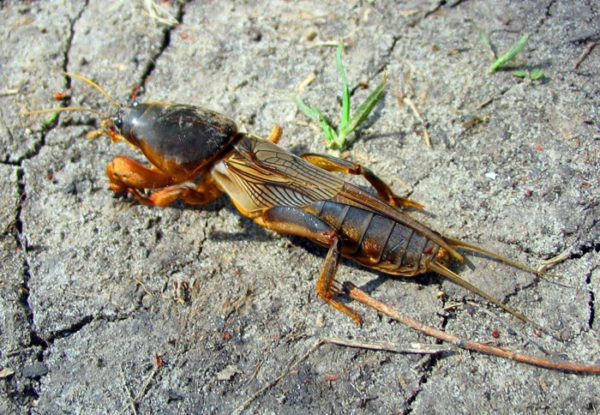
Determine that a pest has started up in the garden will help wilted plants. If the soil is not over dried, and the plants still die, you need to carefully examine the surface of the earth. It is especially good to do it after the rain, then the moves dug by the medvedka are clearly visible,holes and loose mounds of the earth.
What the pest larvae look like
These mounds are most likely nests with laid eggs. To discover and destroy them is of paramount importance, since the development of the larvae occurs very quickly. And very soon hundreds of new voracious insects will grow. Nests are located at a depth of about 15 cm, during the day, Medvedki usually “sit” inside, and in the evening they begin to move to the surface, destroying everything in their path.
The breeding period is at the end of May - the beginning of June, during the period of active work in the garden. If you stir up the nest, you can find a huge laying of eggs, 500-600 pieces, which look like hemp seeds, which turn into larvae on days 14-17, which are already capable of causing significant damage to the garden.
The larvae have almost the same appearance as an adult individual, but still without armor and wings. They very quickly grow to 5-30 mm in length due to the fact that they feed on any vegetation on the site and cause significant damage. And then able to lay hundreds of new eggs.
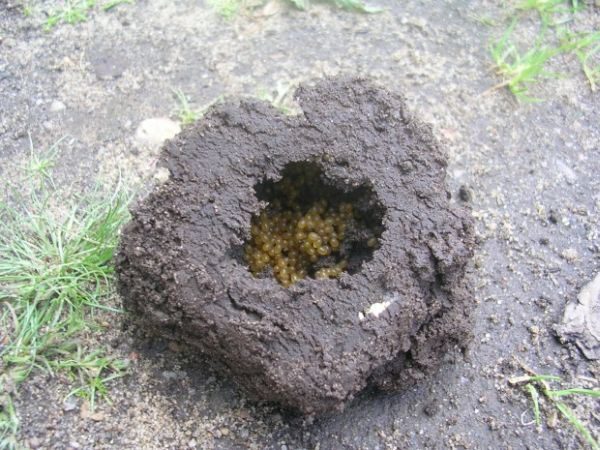
How dangerous is Medvedka for vegetable crops?
The pest is equally dangerous for most vegetables and root crops. Powerful jaws allow Medvedka to easily finish off not only the root system of corn, cabbage, cucumbers, tomatoes, peppers, eggplant, but it is also easy to gnaw out significant pieces of root crops - potatoes, beets. Medvedka can completely destroy the seeds of carrots, radishes, and especially - cucumbers sown in the ground, damage the roots of garden strawberries, flower bulbs, roots of shrubby plants and underground stems.
Do not disdain this omnivorous predator and their own kind - they eat smaller insects living in the ground, worms, dragonfly larvae and ladybirds.
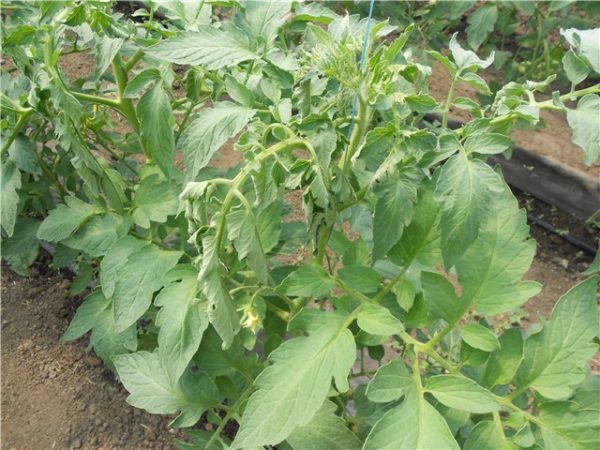
Pest control measures at different stages
The fight against the predatory pest, its complete destruction in the backyard plots is very laborious and troublesome. It is not a simple insect - the bear constantly changes its location, digs holes and passages and it takes a sufficient amount of time to track it down. Therefore, the most effective will be a comprehensive struggle with it, in several ways.
There are many fairly effective methods of dealing with this scourge, which can be divided into two types:
- the extermination of a bear with pesticides;
- the destruction of insects environmentally friendly folk remedies.
Chemicals to destroy the beetle and protect the crop
There are a number of the most potent chemicals that destroy Medvedka very effectively: “Prestige”, “Medvetoks”, “Fenoxin plus”, “Thunder”, “Aktar 25 WG”, “Bankol”, “Parachute”.Instructions for use are on each drug.The principle of operation is the same: pesticide pellets fall asleep in insects and / or nests dug by insects. Adults and larvae will die within 24 hours.
You can make bait and mix it with the drug. As bait serve barley, wheat porridge, mixed with beer (!). A mixture of all the ingredients is rolled into balls and laid out in places of numerous passages, holes with larvae and insects, in the inter-row of beds that need protection - cabbage, tomato, cucumbers, potatoes, and root crops. Excellent bait will serve a mixture of chemical preparations and germinated seeds of cucumber.
- Bankol
- Medvetoks
- Thunder
- Prestige
- Phenaxin Plus
As chemical preparations, it is possible to use kerosene, zinc phosphide, hexachlorane. In the greenhouse, the control measures are similar.
How to deal with Medvedka effective folk ways
The principle of extermination is the same: to find a hole or aisles, lure the smell of bait and destroy the pest, without harming the surrounding nature and themselves. Or vice versa, expel the bear by means of substances with a strong odor, which they do not tolerate.Here are some popular recipes widely used by gardeners:
- With liquid ammonia. 4 dessert spoons of sal ammoniac add to 10 liters of water, water the plants under the root with a solution (0.5 liters for each), trying not to fall on the leaves. The smell of ammonia repels the bear, while the solution serves as a nitrogenous feed for the plants. The only drawback is that it quickly disappears, so it is advisable to repeat the procedure every 7-10 days. It is possible in the aisle to lay out the rags of cloth or rags dipped in ammonia water. The tool is not able to completely kill the beetles, but for some time just scare them.
- Manure trap. Fresh manure (chicken droppings) acts on a bear like valerian on a cat. Therefore, they do not need to fertilize the land, but it will be very useful to make 1-2 traps for 1 hectare. In early May, small piles of fresh manure spread out in the garden. After 15-20 days, you can check - surely there will be adult individuals and eggs laying. It will remain to take them away and destroy.
- Shadow Traps. Pieces of roofing material, cardboard, sheet metal, etc. spread out in open sunny places. In the daytime, the bears will surely climb under them, they can be easily destroyed, only you need to act quickly, without delay.
- Bears are big beer lovers. A three-liter jar with a small amount of beer must be tied with gauze, buried in the ground at a 45-degree angle, so that the neck is at a depth of 4-5cm. Medvedka will surely appear on the smell of beer, will fit into the jar, and will not be able to get back. You will only have to check the traps and change the beer.
- Soapy or oily water. To dissolve washing powder or sunflower oil with water and to fill in holes or passes. Insects will die.
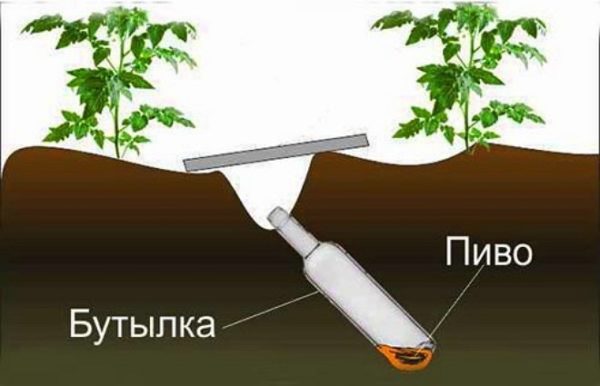
In addition to these folk remedies, many gardeners use egg shells, scattering them in places like the bear holes, as well as peas. In addition, you can build a trap with your own hands. However, not the fact that it will turn out to withdraw all the parasites.
Preventive remedies to get rid of the pest
As a preventative measure, experienced gardeners recommend systematically destroying and venting nests. By getting rid of eggs and larvae in time, it is possible to significantly reduce the number of insects, and even lime in general. To find nests, it is necessary to dig a garden 2–3 times a year, and to find the eggs and larvae burned. This is the only way to save and protect your garden from pests.
The use of complex measures, various traps and chemical agents will help get rid of the annoying pest, save plants and crops from destruction.

